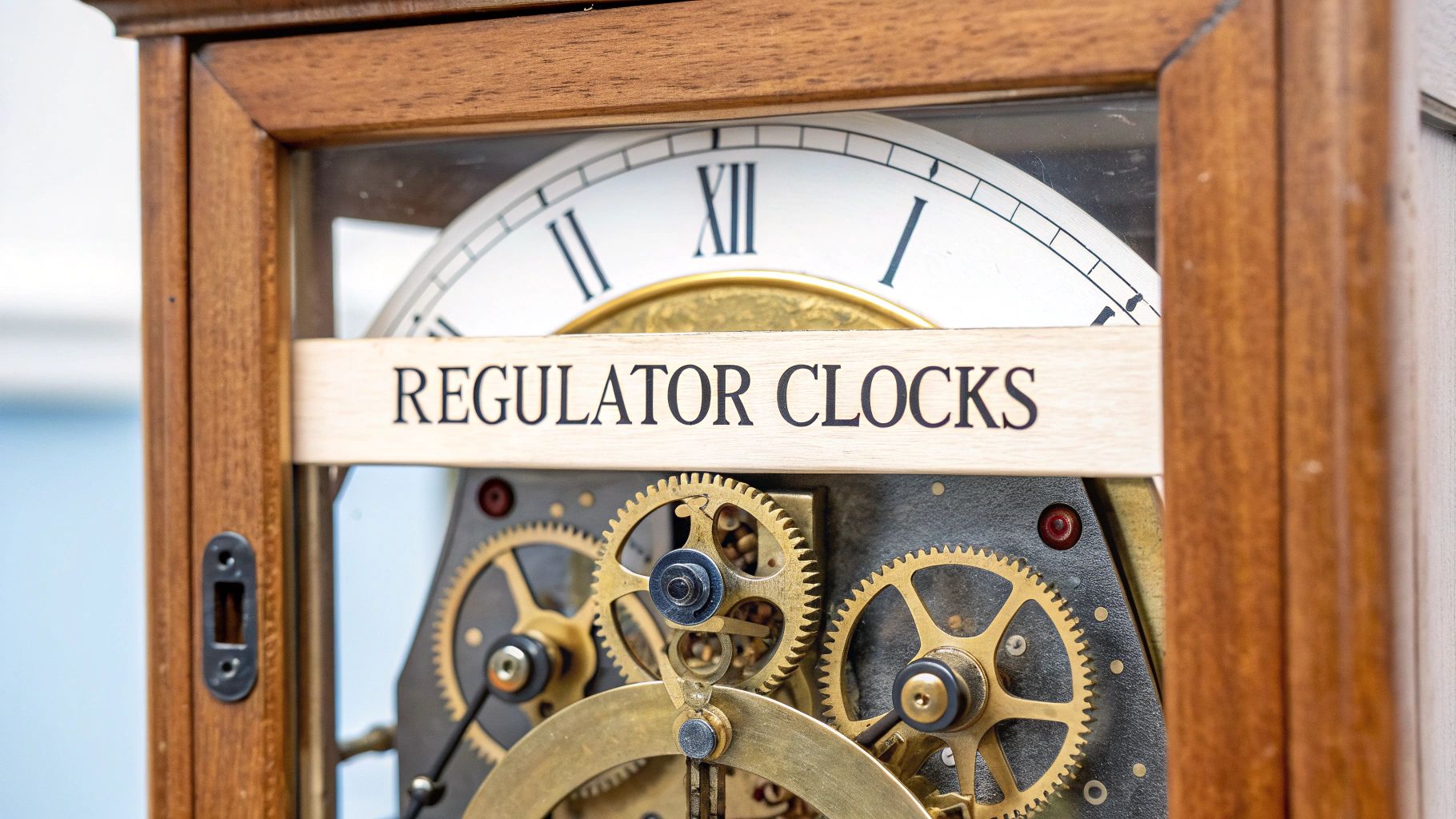Before we had atomic clocks or even quartz watches, how did the world agree on the time? The answer, for over a century, was the regulator clock.
These weren't your average household timekeepers. A regulator was a high-precision instrument, a master clock used as the definitive reference to set all other clocks. Its entire purpose was unmatched accuracy, not just telling time at a glance. You'd find them in the most time-sensitive places: observatories, railway stations, and the workshops of master jewelers. They were the gold standard.
Unlocking the Secrets of a Precision Time Machine
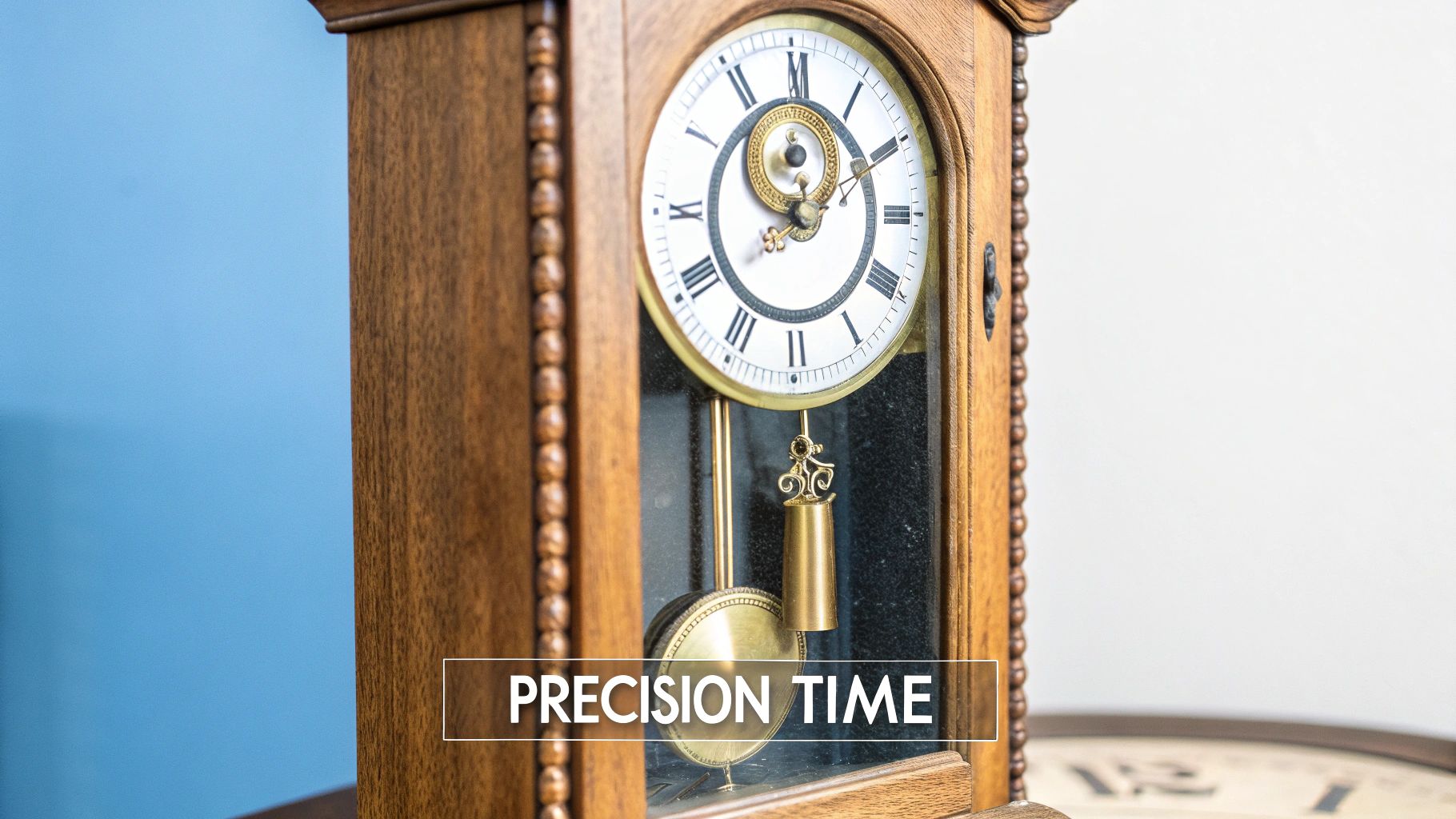
When you look at an antique regulator, you’re not just seeing a clock; you're seeing a purpose-built scientific instrument. Think of it like the certified platinum-iridium cylinder kept in a vault that defines the international standard for a kilogram. You wouldn't use that to weigh your groceries, but it’s the ultimate reference against which all other scales are checked. That's exactly the role a regulator clock played in the world of timekeeping.
Everything about its design was engineered to minimize error. This laser-like focus on precision is what gives regulators their distinct, recognizable look, setting them apart from other clocks of their era.
While many antique clocks were designed as beautiful pieces of furniture that also happened to tell time, a regulator’s appearance is a direct byproduct of its function. You quickly realize its form follows its primary mission: the relentless pursuit of perfect time.
Hallmarks of a Regulator Clock
So, what makes a regulator a regulator? Three key features give them away almost immediately. Once you know what to look for, you can start to appreciate the genius behind their design, as each element plays a critical part in the clock's incredible accuracy.
- The Dominant Pendulum: The long, heavy pendulum is the soul of the clock. Its slow, steady swing is what governs the time, and its design was often a showcase for innovations that counteracted things like temperature changes.
- Separated Dials: You'll notice the hour, minute, and seconds hands aren't all on the same central point. This "regulator dial" was a brilliant solution to prevent the hands from ever covering each other up, allowing for a crystal-clear reading down to the very second. This was absolutely essential for astronomers and watchmakers.
- Superior-Quality Movement: The guts of the clock, its "movement," are built to a much higher standard than your typical timepiece. They have thick, sturdy plates, precision-cut gears, and sophisticated escapements, all designed to reduce friction and deliver power as consistently as possible.
A regulator clock is an honest timekeeper. It skips the fancy carvings and complex chimes for a single, noble goal: to report the passage of time as truthfully as humanly possible.
This specialized role is what really separates it from more common relatives, like the grandfather clock. If you're curious about how they stack up against each other, our detailed guide on grandfather clock antiques is a great place to start. Now, let’s dig a bit deeper into the history, makers, and value of these remarkable instruments.
The Quest for Perfect Time
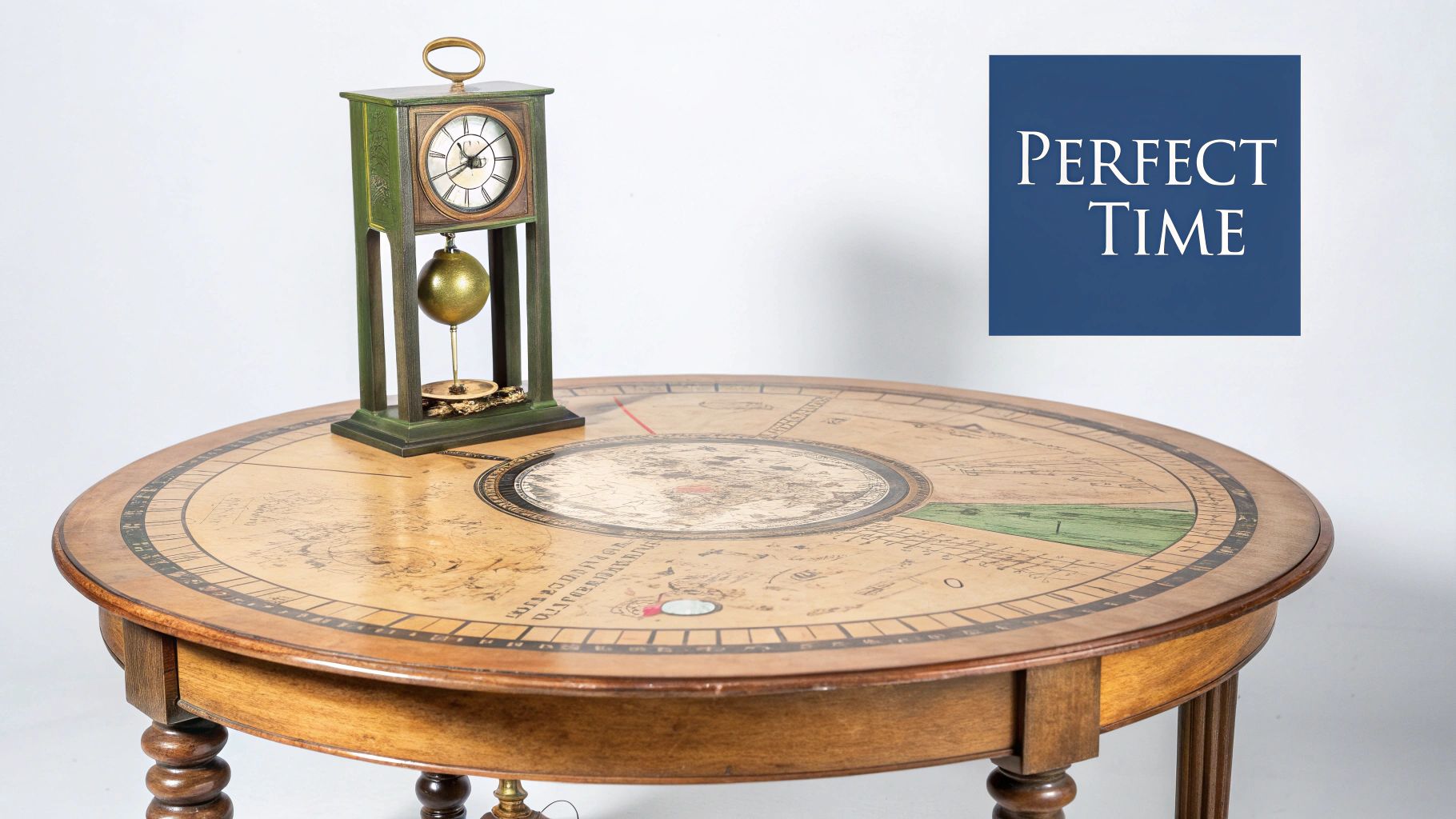
The story of the antique regulator clock isn't about telling time for the home; it's a story of ambition. It started in the cold, quiet halls of 18th-century observatories, where astronomers were in a desperate race to map the heavens.
Their clocks just weren't cutting it. The slightest error, compounding over a few hours, could throw off their celestial calculations entirely. They needed a timekeeper that wasn't just accurate—it had to be the gold standard of accuracy. This scientific pressure kicked off a revolution in clockmaking, giving us the first true regulator clocks. These were instruments, not just decorations, engineered from the ground up to hunt down and eliminate every possible source of error.
This marked a huge shift in thinking. Clockmakers went from building functional timepieces to crafting precision instruments that could measure time with almost perfect consistency. The whole point was to create a "master" clock, a single, unwavering reference point to set every other clock by.
Taming the Heartbeat of the Clock
One of the biggest problems right out of the gate was the clock's escapement. You can think of the escapement as the clock's heart; it's the little mechanism that gives the pendulum a gentle nudge to keep it swinging while letting the gears turn at a steady pace.
Early designs, like the common anchor escapement, had a critical flaw: recoil. Each time a gear tooth was released, it would kick back a tiny bit against the pendulum, messing with its natural, even swing. It was a subtle but constant interference that made true precision impossible.
The big breakthrough came in the 1720s when George Graham invented the deadbeat escapement. His design was genius. It completely eliminated that recoil. When the gear tooth made contact, it landed "dead" on the surface, allowing the pendulum to swing freely, as if guided only by gravity. This single improvement was a game-changer for accuracy and quickly became essential for any serious precision clock, including every regulator worth its name.
Fighting the Laws of Physics
With the escapement sorted, clockmakers ran into another enemy: the weather. Basic physics tells us that metal expands in the heat and shrinks in the cold. For a clock's pendulum, this meant its rod was constantly changing length with the seasons.
A longer pendulum swings slower, a shorter one faster. This tiny change could make a clock gain or lose several seconds a day—a disaster for scientific work. The new challenge was to build a pendulum that could outsmart physics and compensate for temperature changes on its own.
The search for a temperature-compensating pendulum was the clockmaking world's equivalent of the space race. It sparked decades of intense experimentation and some of the most brilliant engineering of the 18th century.
Two clever solutions eventually won out:
- The Gridiron Pendulum: Invented by John Harrison, this design used a series of alternating brass and steel rods. Since brass expands more than steel, the upward expansion of the brass rods would perfectly cancel out the downward expansion of the steel ones, keeping the pendulum's effective length constant.
- The Mercury Pendulum: George Graham came up with this solution, which used a jar of mercury as the pendulum's weight. As the steel rod expanded downward in warm weather, the mercury inside the jar would expand upward, keeping the pendulum's center of gravity in the exact same spot.
From the Observatory to the Railway Platform
As the 18th century rolled into the 19th, the need for precision timekeeping exploded. The Industrial Revolution was in full swing, and the rise of the railway network created a new, urgent demand. With trains running on tight schedules, a few minutes' difference between town clocks could lead to chaos or, even worse, deadly collisions.
Railway companies began adopting antique regulator clocks as the official timekeepers for their entire system. The regulator in a major station became the source of "railway time," the single standard used to synchronize every clock on the line. This took the regulator from a niche scientific tool to a vital piece of public infrastructure—the silent, steady heartbeat of a newly interconnected world.
How to Identify a True Regulator Clock
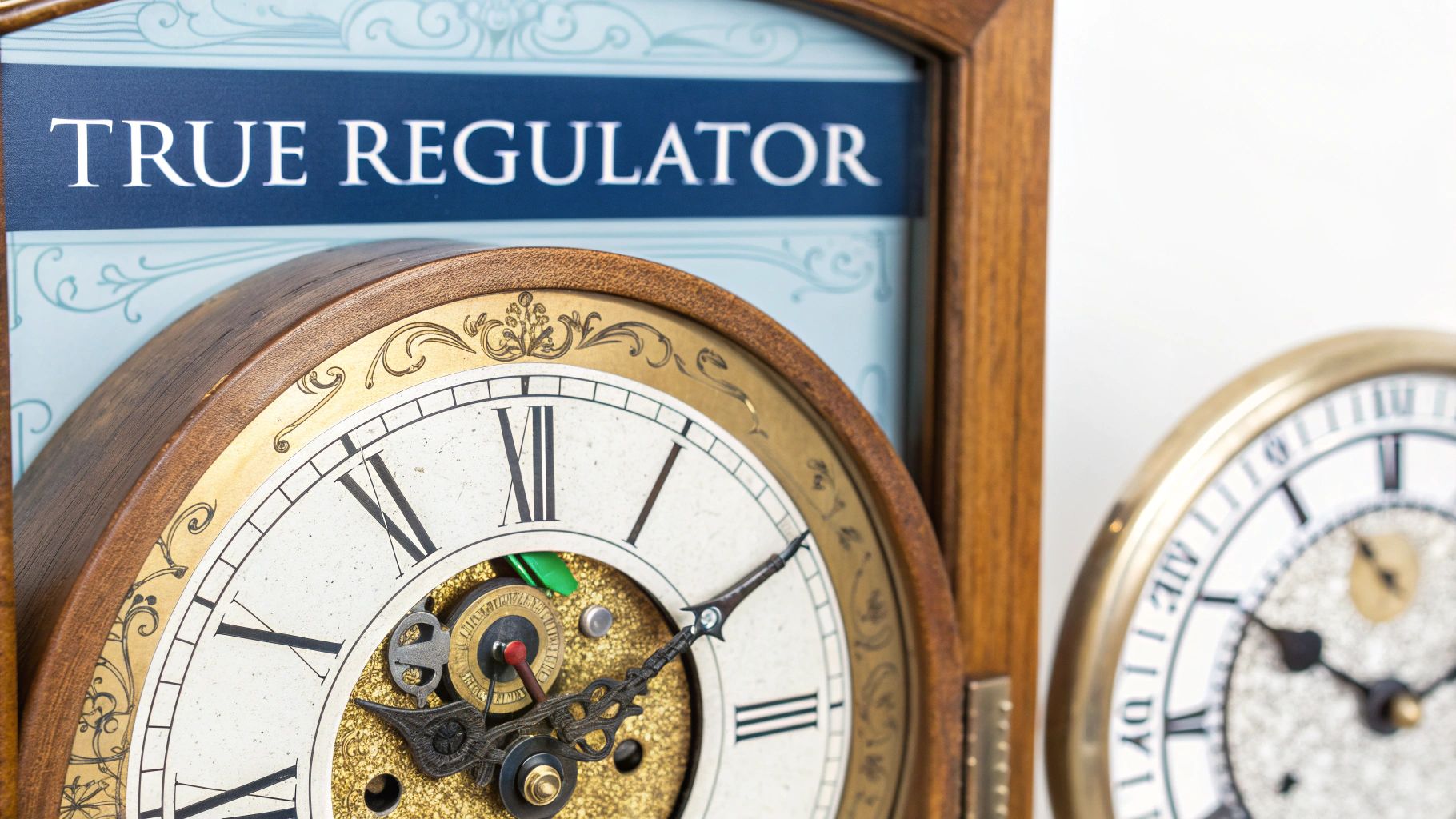
It can be a little intimidating to tell one antique clock from another, but spotting a genuine regulator is actually pretty straightforward once you know what to look for. With these clocks, form follows function. Every design choice was made for one reason and one reason only: to be the most accurate timekeeper possible.
Forget ornate decoration for a moment. Instead, we'll focus on a few key engineering features that will train your eye. These clues aren't just aesthetic quirks; they're the tell-tale signs of a true master timekeeper.
The Unmistakable Regulator Dial
The first thing you’ll probably notice is the dial. It just looks different. Unlike a typical clock where all the hands share a single pivot point in the center, a regulator’s dial separates them out.
This layout, known as a regulator dial, was a masterclass in practical design. Imagine you're an astronomer or a watchmaker needing to set other clocks with perfect precision. You'd need a completely clear view of the seconds hand.
- Dominant Minute Hand: The big hand in the center of the dial? That’s for the minutes. For precision work, this was the most critical measurement.
- Sub-dial for Hours: Tucked away on a smaller sub-dial, often in the top half, is a little hand that tracks the hours.
- Sub-dial for Seconds: You'll find another sub-dial, usually on the bottom half, dedicated entirely to the sweeping seconds hand.
This clever separation means the hour and minute hands never, ever get in the way of the seconds hand. It’s a purely functional layout that screams "this is a serious scientific instrument."
The Heartbeat: A Precision Pendulum
If the dial is the face of the regulator, the pendulum is its heart. Its long, heavy, and steady swing is what creates such incredible accuracy, and clockmakers were constantly tinkering to perfect it. Sure, a standard grandfather clock has a pendulum, but a regulator's is on another level entirely.
You’re looking for a pendulum engineered to fight back against physics. Even tiny changes in room temperature can make a metal rod expand or contract, throwing off the clock's timing.
The pendulum in a true regulator isn't just a weight on a stick; it's a finely tuned scientific instrument designed to defy the laws of physics and maintain a perfectly consistent beat.
Keep an eye out for one of two classic temperature-compensating designs: the gridiron pendulum, with its unique cage-like structure of brass and steel rods, or the mercury pendulum, which uses a glass jar of mercury as the bob. Spotting either of these is a dead giveaway that you’re looking at a high-end regulator.
Examining the Superior Movement
Finally, let's talk about the engine of the clock—the movement. Even though it's usually hidden inside the case, the quality of the gears and plates is what sets a regulator apart. These movements were built like tanks.
They have thick, heavy brass plates and gears with incredibly fine, delicate-looking spokes (known as wheel crossings). Everything was built to reduce friction and transfer power from the weights to the pendulum as smoothly as possible. A top-tier deadbeat escapement, which prevents the recoil that could disturb the pendulum’s natural swing, is another must-have for any authentic antique clocks regulator.
To make these distinctions even clearer, it helps to see a side-by-side comparison.
Regulator Clock vs Standard Antique Clock Features
The table below breaks down the key differences between a purpose-built regulator and a more common antique clock, like a longcase or grandfather clock from the same period.
| Feature | Antique Regulator Clock | Standard Antique Clock (e.g., Longcase) |
|---|---|---|
| Dial Layout | Separated dials for hours, minutes, and seconds. | All hands are concentric (share the same center). |
| Primary Focus | Unmatched accuracy and precision reading. | Decorative appeal and general timekeeping. |
| Pendulum | Often a temperature-compensating design (mercury or gridiron). | Typically a simple brass-faced lead bob on a single rod. |
| Movement | Heavy-duty plates, high-grade gears, and a deadbeat escapement. | Lighter construction, simpler mechanics. |
| Chimes | Almost never has chimes, as they could interfere with accuracy. | Often includes striking or chiming mechanisms. |
As you can see, every element of a regulator's design was optimized for performance, often at the expense of decorative features like chimes, which were seen as an unnecessary complication that could disturb the movement's stability.
Famous Makers and Regional Styles
You can't really talk about regulator clocks without talking about the master craftsmen who built them. The story of these timekeepers is deeply tied to the places they came from. While every regulator was built for precision, the cases, dials, and even the tiny mechanical details can tell you if it was made in the delicate workshops of Vienna or the powerhouse factories of America.
Knowing these regional differences is like learning to read the clock's DNA. It helps you see beyond the gears and weights to appreciate the artistry and recognize the hand of some of history's most important clockmakers.
The Elegant Vienna Regulators
For many, the quintessential regulator clock is a Vienna regulator. These Austrian marvels, crafted from the late 1700s through the 1800s, are famous for their graceful, almost minimalist, look. They were designed to be shown off, with slender, glass-fronted cases that put the slow, hypnotic swing of the pendulum and the gleam of the polished weights on full display.
The Viennese style was all about visual harmony. You'll often see a few key traits:
- Simple, elegant cases: Think clean lines and fine woods like walnut or mahogany, with just enough detail to catch the eye.
- "Pie-crust" bezels: This is a classic Viennese signature—a distinctive scalloped metal ring around the dial.
- Porcelain or enamel dials: These usually have crisp Roman numerals and beautifully delicate hands.
Viennese makers were true artists, building scientific instruments that could easily be the centerpiece of a refined home. The early Biedermeier period examples are treasured for their stunning simplicity, while the later "Historismus" models from the late 19th century have more elaborate, ornate designs.
Vienna regulators represent the perfect marriage of science and art. They were precision instruments designed with the soul of a piece of fine furniture, meant to be admired as much for their beauty as for their accuracy.
American Precision and Industrial Might
American clockmakers had a completely different philosophy. Their regulators weren't so much about delicate artistry as they were about bulletproof precision and reliability. These were tough, no-nonsense machines built for the demanding environments of railway stations, factories, and observatories.
When you think of American regulators, one name stands above the rest: E. Howard & Co. of Boston. For many collectors, an E. Howard is the absolute gold standard of American clockmaking. Their movements are legendary for their quality, and their cases have a distinctive, often wonderfully understated, design.
The other giant on the scene was the Seth Thomas Clock Company. They made a huge number of regulators that became fixtures in schools and businesses across the country, all known for being dependable workhorses. American regulators are often over-engineered, with heavy, robust movements built to last forever and keep perfect time, no matter what. They perfectly reflect the nation's obsession with practicality and industrial power.
German and English Horological Prowess
German clockmakers, especially those from the famous Black Forest region, were known for their incredible technical skill. Makers like Gustav Becker produced a staggering number of high-quality regulators, often mixing the elegance of Viennese design with solid German engineering. His clocks were shipped all over the world and became a common sight in homes and offices.
Over in England, clockmakers were the ones who wrote the first chapter of precision timekeeping. Masters like John Harrison and George Graham did the foundational work that made the regulator clock possible. English regulators are all about the movement; the cases can be incredibly plain and functional, giving you no hint of the brilliant mechanism inside. These clocks were often built for scientific institutions where accuracy was the only thing that mattered. That legacy of pure, unadorned performance is the true hallmark of the English regulator.
How to Figure Out What Your Clock is Worth
Trying to pin down the value of a regulator clock isn't like looking up a price in a catalog. It’s a lot more like appraising a vintage car. A whole host of factors come into play, from the name on the dial to the tiniest original screw, and they all add up to its final worth.
Getting a professional appraisal is always the surest way to get an accurate number. But understanding what drives the value yourself is incredibly helpful. It gives you a real feel for why two clocks that look almost identical can be worlds apart in price, which is essential whether you're buying, selling, or just insuring a treasured heirloom.
The Power of a Good Name
Often, the single biggest factor influencing a regulator's value is the maker. A clock signed by a famous horologist or a respected company is like a seal of quality, and it immediately makes the clock more desirable. This is where names like E. Howard & Co. or Gustav Becker really shine.
Think of a signed clock from a top-tier maker like a painting signed by a master artist. That signature guarantees a certain level of craftsmanship, historical importance, and brilliant engineering. Unsigned clocks, even beautifully made ones, almost always sell for less because their origin is a question mark.
How Rare Is It?
Rarity is another huge piece of the puzzle. Was this a model churned out by the thousands, or was it a special commission or a limited run? A clock with a documented history—what we call provenance—that ties it to a specific place like an observatory, university, or railway station adds a story that collectors absolutely love.
An antique regulator with a verifiable story—one that places it at the heart of scientific or industrial history—transforms it from a mere timekeeper into a tangible piece of the past. This historical connection can dramatically increase its value.
Condition and Originality: The Golden Rules
In the antiques world, condition is everything. A regulator in pristine, untouched condition is the ultimate find for any collector. This isn't just about how the wooden case looks; it applies to every single part of the clock.
Here’s what experts and serious collectors are looking for:
- Original Finish: Has the case been stripped and refinished? Believe it or not, an original finish, even with the patina of age, is almost always more valuable.
- Original Glass: Old glass often has charming little imperfections, like bubbles or waves. Replaced glass, especially on the main door, is a definite knock against its value.
- Original Movement: Are all the gears, plates, and the escapement original to that specific clock? A "married" movement, where parts from different clocks are pieced together, is a major red flag for collectors.
- Original Dial, Hands, and Pendulum: These are the face of the clock, and their originality is critical. Any replacements or major touch-ups will impact the price.
Market Trends and Today's Prices
Like any market, the world of antique clocks ebbs and flows. High-end, rare pieces from the best makers are still commanding incredible prices at auction. Just recently, a Howard & Company (Boston) No. 43 astronomical floor regulator sold for an astounding $254,100. It set a new record for an E. Howard clock and shows just how strong the demand is for the best of the best.
On the other hand, the market for more common, mid-range clocks has softened a bit. For instance, a nice Vienna regulator that might have fetched $700-$800 a decade ago might only bring $300-$500 today. This shift reflects changing tastes in collecting and interior design. For a broader look at how these market forces work, this antique value guide offers some great general insights.
Essential Care for Your Antique Timepiece
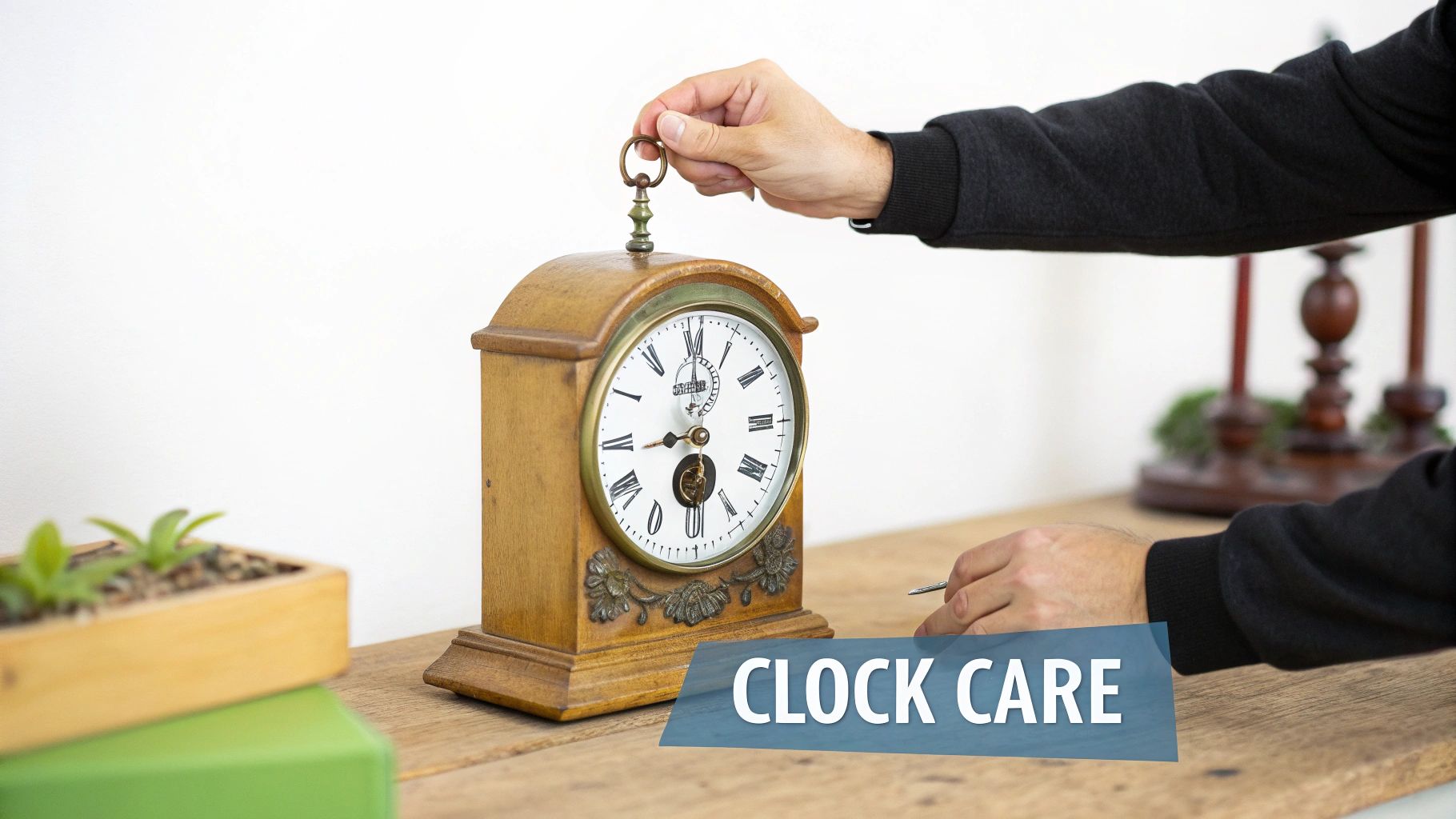
When you own an antique regulator clock, you’re not just an owner—you’re a caretaker for a piece of history. Keeping it in good shape isn’t complicated, but it does require a bit of gentle, consistent attention to preserve its legacy.
The first step is simply finding the right spot for it. Your clock’s worst enemies are direct sunlight, big temperature swings, and instability. You'll want to place it on a sturdy, level floor, securely against a wall where it won’t get knocked around. Keep it away from radiators, fireplaces, or sunny windows, which can warp the wooden case and throw off the delicate movement.
Winding and Routine Checks
Winding will be your most common task. It’s crucial to use a key that fits perfectly to avoid stripping the winding squares. Just turn the key slowly and gently until you feel it stop. Never force it further. That's the fastest way to snap the mainspring, which means an expensive trip to the repair shop.
Beyond winding, just pay attention. Get used to the sound of your clock. A happy clock has a steady, even "tick-tock." If you hear any strange new noises, it might be a sign that something needs a look.
"A well-cared-for regulator clock is more than just a timekeeper; it's a living piece of history. Regular, gentle maintenance is the key to ensuring it continues to tell its story for generations to come."
The Importance of Professional Servicing
While you can handle the day-to-day care, the internal mechanics are best left to a pro. It’s a bit like owning a vintage car—you handle the washing and fill the tank, but a specialist mechanic does the engine work. You should have the movement of your antique clocks regulator serviced by an expert every 5 to 7 years.
Here’s what a professional servicing involves:
- Disassemble and clean: The horologist will take the entire movement apart, cleaning every piece to remove old, sticky oil and built-up grime.
- Inspect for wear: They'll check all the pivots, bushings, and gears for any wear that could be hurting the clock's accuracy.
- Lubricate properly: The right kind of specialized clock oil is applied to keep everything moving smoothly and reduce friction.
Trying to fix a complex regulator movement yourself is a huge risk and can easily lead to permanent damage. The wooden case, on the other hand, is something you can care for. For some great tips on keeping the finish looking its best, you can learn more about cleaning antique wooden furniture.
A Few Common Questions About Regulator Clocks
Even people who've been around antique clocks for years can have questions about regulators. Their specific design and history spark a lot of curiosity. Let's tackle some of the most common ones I hear.
Think of this as bridging the gap between simply admiring a regulator's beauty and really getting what makes it tick.
Just How Accurate Are These Old Clocks?
It's actually mind-blowing. A top-quality antique regulator clock, properly cared for, might only lose or gain a few seconds over an entire month. These were the pinnacle of timekeeping technology in their day, and a good one can still easily keep better time than many of today's mechanical wristwatches.
Of course, that level of precision isn't a given. It really comes down to three things:
- The Maker's Skill: The quality of the original movement is everything.
- The Pendulum: A temperature-compensating pendulum, like a mercury or gridiron type, is key to steady performance.
- Proper Maintenance: Just like a classic car, it needs regular, professional servicing to run at its best.
Are All Regulator Clocks Meant for the Wall?
That's a common misconception, probably because the long, elegant Vienna-style wall clocks are so famous. But no, regulators come in all shapes and sizes. The defining feature isn't the case—it's the high-precision movement and the separate dials for hours, minutes, and seconds.
You'll find massive floor-standing regulators, sometimes called astronomical regulators, that were built for observatories where rock-solid stability was non-negotiable. There are even smaller shelf or mantel regulators, though they are much rarer. The wall-mounted design was just a practical and popular solution for giving the long pendulum the room it needed to swing.
A regulator clock is defined by its purpose—unwavering accuracy—not by its shape or size. The form simply follows the function, whether it's hanging on a wall or standing commandingly on the floor.
What Is the Safest Way to Move My Clock?
Very, very carefully. Moving a regulator clock is a delicate operation, and its finely-tuned mechanism is incredibly easy to damage. Before you move it even an inch, you absolutely must secure or, better yet, completely remove the pendulum and weights.
The pendulum is the most fragile part. If it's left to swing around during a move, it can snap the thin suspension spring at the top or wreck the escapement. For anything more than just sliding it to a new spot in the same room, I always recommend hiring a professional clockmaker (a horologist) to handle it. It's just not worth the risk.
Have a family heirloom or a recent find you're curious about? The Curio app turns your phone into an antique expert. Snap a photo to instantly identify your items, learn their history, and get an estimated value. Download Curio today and uncover the stories hiding in your home. Find out more at https://www.curio.app.
